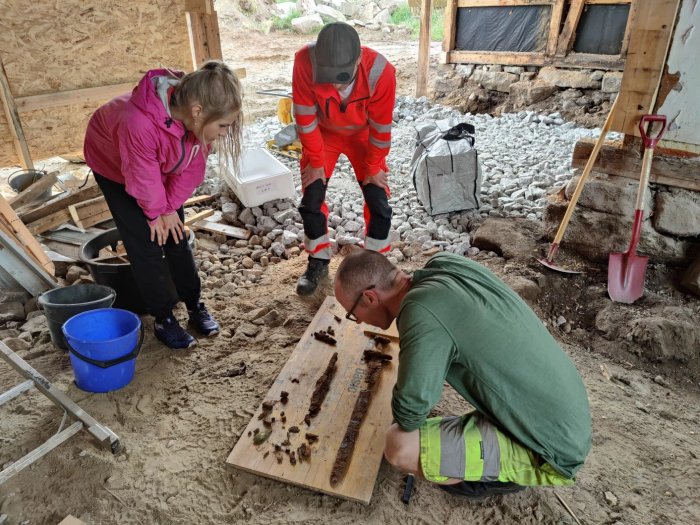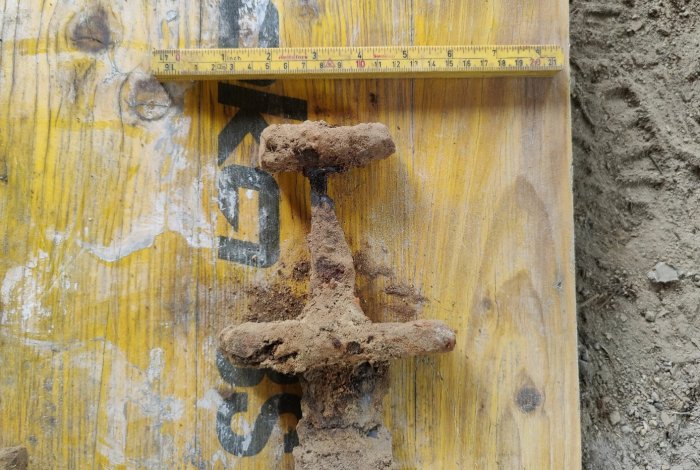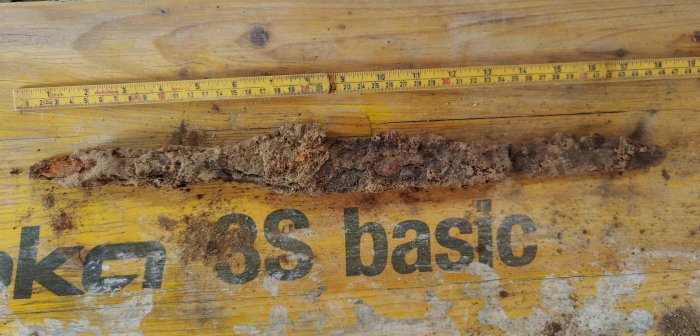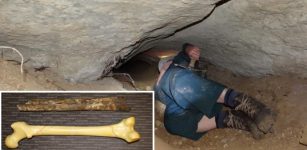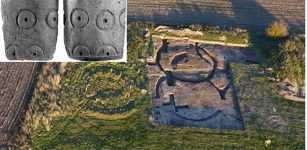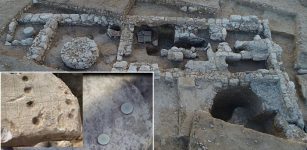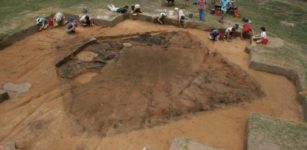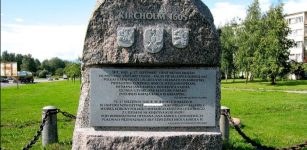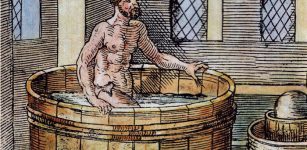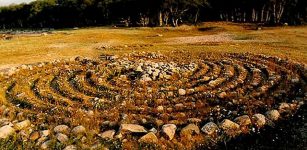Viking Grave And Sword Discovered In Norwegian Garden
Jan Bartek - AncientPages.com - Sometimes, you don't have to go far to make an incredible archeological discovery, but few of us expect to find something of historical value in our homes. Yet, this rather unusual scenario does happen occasionally. A Norwegian couple was extending their home when they suddenly noticed something unusual sticking up from the earth. It looked like a sword, and that is exactly what it was.
There are quite a few Viking swords in Norway, more specifically around 3500. And weapon graves are not unique. But it is still extremely rare to discover Viking swords and Viking graves. And the grave in question this time was richer than many, with very well-preserved items. (Photo: Joakim Wintervoll)
Oddbjørn Holum Heiland and his wife Anne were digging behind the Setesdalshouse from 1740, which they wish to extend.
Heiland was not planning on digging much at all, just a little bit in the slope behind the house, to get some more space between the house and the land.
When he removed the grass and the top soil, he found an oblong stone. He didn’t think much of it, put it aside, and kept digging.
When the digging bucket dug into the next layer, the moraine under the top soil, an iron thing all of a sudden popped up.
“I looked at it and thought that this looks a loot like a sword blade. And then when I released the contents of the digging bucket, the hilt of the sword fell out, ”Heiland told Science in Norway.
Heiland understood the stone must be a gravestone of some kind. He looked for more information on the internet and "found an almost identical sword from the Viking Age which was found in another part of the country some time ago.
“That’s when I realized that this must be some Viking stuff,” he says.
Heiland did exactly what archaeologists want the public to do when they find something the suspect to be of historical and archeological value. He stopped digging and placed the object he had retrieved in a safe place. Then, he contacted the county municipality and reported the discovery.
It did not take long for county archaeologist Joakim Wintervoll in Agder county municipality and Jo-Simon Frøshaug Stokke from the Museum of Cultural History in Oslo to visit the Norwegian couple and look at the curious find. Once they did, these experts could confirm it was a Viking had been out to rest here long ago.
As reported by Science in Norway, "it’s the make of the sword that allows the archaeologists to date the find. The two pieces of the sword that were found make out a 70 cm long sword, and the blade is 5 cm at the broadest point.
“But it’s the hilt that tells us this is a sword from the Viking Age,” Wintervoll explains.
The hilt of a sword is an object of fashion, and the style of the hilt found in Setesdal places it at around the end of the 800s and the beginning of 900.
“We have datings for different styles of hilts from year zero, so we have a pretty good overview of how these hilts have changed from the early Iron Age and into the Middle Ages,” Wintervoll says.
The grave in Setesdal didn’t just contain a sword and a possible gravestone. A lance, a long spear designed to be used on horseback, had also been placed in this grave. So far however, no other traces suggest that this is the grave of a mounted warrior.
Glass beads gilded with gold and a belt buckle were also found.
“When we were about to put the buckle in the box that goes to the museum, we saw a glimmer of gold in the surface, so we believe that perhaps also the buckle was gilded with gold,” Wintervoll says.
And finally, a brooch had also been laid down in the grave, the sort that could be used to keep a cape in place. It is made of bronze and had a typical Viking animal motif.
A particularly rich weapon grave
“It’s very rare to discover weapon graves from the Viking Age, and this grave is a little richer than we are used to. The objects are also a bit better preserved than what we normally have to work with,” says Jo-Simon Frøshaug Stokke, the archaeologist at the Museum of Cultural History in Oslo who accompanied Wintervoll in examining the find.
“Usually, we find one or two objects, not like here where there is a set of weapons with both a sword and a lance, and then also jewellery,” he says.
Though rare, the find is not unique.
A Viking from the upper echelons was laid to rest in Anne and Oddbjørn Holum Heiland’s garden with weaponry and jewellery, about 1200 years ago. (Photo: Joakim Wintervoll)
“This is a set of weapons that we know well from other Viking Age graves. And Setesdal is an area where we have also previously found this type of weapon grave,” Stokke explains.
Whoever was buried here once upon a time was from the higher echelons of society.
“Even if we often imagine Vikings with helmets and swords, very few Vikings could actually afford this,” Stokke says.
Most of the Vikings that went on raids brought farmers weapons with them, such as axes and spears. In this grave, somebody has been buried with both a sword and a lance.
“These weapons alone make this a rich grave, but then you have the jewellery as well. So this is a person who clearly had some resources,” Stokke says.
And the jewellery could no doubt have belonged to a man.
The hilt, the handle of the sword, tells the archaeologists that this sword is from the Viking Age. (Photo: Joakim Wintervoll)
“When we see weapons we think man, and when we see jewellery we think woman. But this is a very modern divide,” the archaeologist says.
The stone that covered the grave is about 50x100 cm. The weapon grave was right under the stone, which perhaps had laid there untouched, for more than a thousand years. (Photo: Joakim Wintervoll)
“The Vikings liked to wear jewellery. It's not at all unique to find jewellery in a man’s grave, these were fancy people. And then there is the discussion on whether women carried weapons, and there are some indications of that as well.”
Visible graves claim ownership
The grave might not have been very big. Perhaps it was just a pit in the ground, which was then covered by a stone. That the grave was placed exactly in this spot is not a coincidence.
“Burying is done by the descendants of those who have died. They are claiming the land where the person lies,” Stokke explains.
There used to be a collection of smaller farms just 100-150 metres away from where the grave is located. It is reasonable to assume that these farms existed back at that time, or perhaps even further back in time, according to the archaeologist.
Two parts that fit together of a lance were also found in the grave. (Photo: Joakim Wintervoll)
“A pattern that we see is that you bury those who have owned land near the farm, and often in a spot that is easily visible from the nearby roads. People who passed by would then see the grave and know that the people who live here have ancestors who have lived here for a long time. These are our relatives; we lay claim to this land and have done so for generations. This is the function of the visible grave,” Stokke says.
Glass beads gilded with gold as well as a gilded belt buckle were found in the grave. And a number of pieces of metal that may or may not be related to the find. (Photo: Joakim Wintervoll)
The Setesdal-grave bears no traces of a mound, but the oblong stone that Oddbjørn Holum Heiland found was most likely a gravestone. It has either been laid flat on top of the grave or been placed in upright position.
See also: More Archaeology News
Archaeologists will now examine the grave and see if they can find any bones or more Viking Age artifacts. It is a remarkable find that Oddbjørn, and his wife Anne find as exciting as the archaeologists.
As stated at the beginning, it does happen people find Viking Age artifacts or graves where they live. Recently a man in Sweden found a Viking Age skeleton in his garden.
Written by Jan Bartek – AncientPages.com Staff

